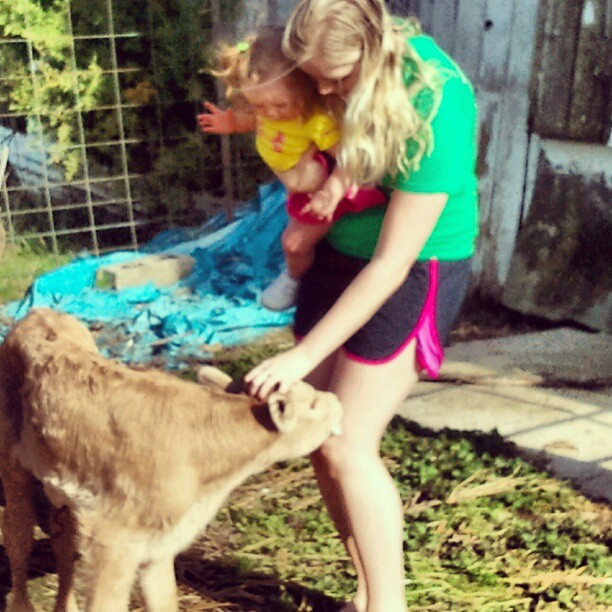I wrote about the spring calves being born a couple of weeks ago, but today I want to talk about bottle calves. Farmers take in bottle calves for one of two reasons: 1) the mama isn’t taking care of it, or 2) it’s so sick/weak that it won’t survive out in the fields.
So far this year, we have no bottle calves. Last year was the first time I’d helped take care of one (which is another sign that I haven’t been on a farm my whole life; farm kids love taking care of bottle calves!). So here is the story of Ceffie the Bottle Calf.
It was a wet and cold April weekend; the air had a biting chill to it, and the sky was a slate grey that showed no signs of spring. The pastures and cattle lots were so sloppy, with deep mud holes and pools of rain water filling them up. It was a miserable weekend to be calving.
I was at home, and I don’t remember what I was doing at that particular moment, but I heard a loud bang on the back door and Cass hollering my name. I jumped up and flung open the door, and there was Cass and his dad, toting two very damp, shaking calves. I squealed. I can’t help it. Calves are adorable. I held the door open for them and watched as they (very carefully) made their way down the basement steps. We situated the two calves in a nest of old comforters and dusty quilts, rubbing their coarse hair dry. A small space heater was also set up next to the shivering twins, but they were still wet and obviously cold.
“Go get your hair dryer,” Cass told me.
“Huh?” I answered stupidly.
“Your. Hair. Dryer. We need to dry them off,” Cass explained patiently.
“Oh.” I turned and scampered up the stairs, returning with my black and white polka dotted dryer. I plugged it in, turned it on high, and spent almost half an hour air drying those poor babies. They blinked at me with heavily-lashed, huge brown eyes, and my heart melted. Ugh. Too cute.
Once the calves were dried, we sat on the basement floor watching the poor fellas and feeding them oversized nursing bottles of milk replacement. He told me that the calves had been born in the barn, which was good; but then the mama moved them outside, which was bad. The calves were soaked with rain, and when the mama finally got smart enough to go back inside, the weaker calf (who had a dull, beige-y coat) couldn’t follow. Cass and his dad rescued the smaller calf, then realized the stronger one (who had a prettier, rusty red color) was with the mama… but laying on the cold ground, as Mama was stretching herself out on all of the hay. So they rescued him, too. Mama wasn’t very happy about it, but the red calf was still wet and cold and needed to warm up fast.
The calves stayed in our basement overnight. The next morning, Cass went down to check on them. The red one was standing (which was very good); the tan one was not. I watched as Cass picked up the calf by his tummy, standing him up, then held my breath as the calf stood for one wobbly moment before collapsing again. Poor thing.
Since the red calf was dry and healthy, Cass took him back out to the Mama. Tan calf, or as we so affectionately dubbed him “Ceffie”, was stuck in the basement. He couldn’t go back out until he could stand by himself.
Side note: If calves can’t stand, they can’t nurse from their mama, and then they are more likely to die. Cass wasn’t being a meanie. He was trying to save the little guy’s life.
We continued bottle feeding the calf in our basement for another two days until he could finally stand up and walk around the basement on his thin little legs. Cass tried to put Ceffie back with his brother and mama, but mama wouldn’t take him. This is kind of common for cows that have twins; they will “keep” one, but not the other.
Since Ceffie couldn’t go back to his mama, we had to continue bottle feeding him. A separate pen was set up outside for him, where he could access the shelter of the barn but not the other cattle. Twice a day, Cass and I would fill up the nursing bottle (it holds two quarts of milk replacement!) and feed Ceffie.
I can’t think of anything to compare feeding a calf to. They are very nosy and pushy. They’ll shove your hands, arms, legs, or whatever it is in their way to search for more; they wipe massive trails of nose slime and spit across your hands when searching for the nipple, then suck on it so hard that the bottle sometimes collapses. Calves are jumpy little creatures until you try to feed them; then they will do anything to get close to you. Once the food is gone, you are Stranger Danger again.
Ceffie got a little friendlier the older he got, and I took my niece (who was just barely a year old) out to see him. 
Ceffie stayed in his cozy little lot for a few weeks, until he was old enough to start eating “big kid” feed instead of just milk. Once Cass thought he was strong enough to run with the other calves, he let him out into the larger cattle lot. I don’t think I could pick Ceffie out of a crowd now, but just getting to take care of him personally for that short time was a fun and eye-opening experience for a former Town Girl. I hope we don’t have to “rescue” another one like that this year, but I’ll never turn down an opportunity to raise a bottle calf!